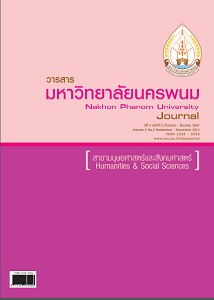การเปรียบเทียบผลสัมฤทธิ์ทางการเรียนและทักษะในการคิดวิเคราะห์ ของนักเรียน ชั้นประถมศึกษาปีที่ 5 เรื่องประโยค ระหว่างการจัดกิจกรรม การเรียนรู้แบบ CIPPA กับแบบ 4 MAT
Main Article Content
บทคัดย่อ
การวิจัยครั้งนี้มีวัตถุประสงค์เพื่อ 1) หาประสิทธิภาพของแผนการจัดการเรียนรู้ตามเกณฑ์ 80/80 2) หาค่าดัชนีประสิทธิผลของ การจัดการเรียนรู้เรียนแบบ CIPPA และการจัดการเรียนรู้แบบ 4 MAT 3) เปรียบเทียบผลสัมฤทธิ์ทางการเรียน เรื่อง ประโยคของ นักเรียนชั้นประถมศึกษาปีที่ 5 ที่จัดการเรียนรู้แบบ CIPPA และจัดการเรียนรู้แบบ 4 MAT 4) เปรียบเทียบทักษะในการคิดวิเคราะห์ เรื่อง ประโยคของนักเรียนชั้นประถมศึกษาปีที่ 5 ที่จัดกิจกรรมการเรียนรู้แบบ CIPPA และแบบ 4 MAT 5) ศึกษาความพึงพอใจของ นักเรียนที่มีต่อการเรียนรู้แบบ CIPPA และการเรียนรู้แบบ 4 MAT กลุ่มตัวอย่างที่ใช้ในการวิจัย จำนวน 44 คน เป็นนักเรียนชั้นประถม ศึกษาปีที่ 5 ประกอบด้วยโรงเรียนบ้านโพนก่อ จำนวน 23 คน และโรงเรียนบ้านรามราช จำนวน 21 คน สำนักงานเขตพื้นที่การศึกษา ประถมศึกษานครพนม เขต 2 ภาคเรียนที่ 1 ปีการศึกษา 2555 ได้มาโดยการสุ่มแบบกลุ่ม ได้แก่ การจัดการเรียนรู้แบบ CIPPA และ การจัดการเรียนรู้แบบ 4 MAT รูปแบบละ 12 ชั่วโมง เครื่องมือที่ใช้ในการวิจัย ได้แก่ แบบทดสอบผลสัมฤทธิ์ทางการเรียน เรื่อง ประโยค ชนิดเลือกตอบ 4 ตัวเลือก จำนวน 30 ข้อ มีค่าความยากระหว่าง 0.20-0.48 ค่าอำนาจจำแนกระหว่าง 0.21-0.87 มีค่า ความเชื่อมั่นเท่ากับ 0.96 แบบทดสอบการคิดวิเคราะห์ ชนิดเลือกตอบ 4 ตัวเลือก จำนวน 20 ข้อ มีค่าความยากระหว่าง 0.20-0.50 ค่าอำนาจจำแนกระหว่าง 0.33-0.69 มีค่าความเชื่อมั่น เท่ากับ 0.89 แบบความพึงพอใจที่มีต่อการจัดการเรียนรู้แบบ CIPPA และแบบ 4 MAT มีค่าอำนาจจำแนกระหว่าง 0.23-0.73 มีค่าความเชื่อมั่นทั้งฉบับเท่ากับ 0.88 สถิติที่ใช้ในการวิเคราะห์ข้อมูล ได้แก่ ร้อยละ ค่าเฉลี่ย ส่วนเบี่ยงเบนมาตรฐาน และการทดสอบสมมติฐานใช้ t-test ผลการวิจัยพบว่า 1) การจัดกิจกรรมการเรียนรู้แบบ CIPPA มีประสิทธิภาพ E1/E2 เท่ากับ 88.55/82.46 ส่วนการจัดกิจกรรมการเรียนรู้แบบ 4 MAT มีประสิทธิภาพ E1/E2 เท่ากับ 85.85/80.63 2) ดัชนีประสิทธิผลของการจัดกิจกรรมการเรียนรู้แบบ CIPPA มีค่าเท่ากับ 0.6782 ส่วนดัชนีประสิทธิผลของการจัดกิจกรรมการเรียนรู้ แบบ 4 MAT มีค่าเท่ากับ 0.6473 3) นักเรียนที่จัดกิจกรรมการเรียนรู้แบบ CIPPA มีผลสัมฤทธิ์ทางการเรียน สูงกว่าการจัดกิจกรรม การเรียนรู้แบบ 4 MAT อย่างมีนัยสำคัญทางสถิติที่ระดับ .05 4) นักเรียนที่จัดกิจกรรมการเรียนรู้แบบ CIPPA มีการคิดวิเคราะห์ สูงกว่า การจัดกิจกรรมการเรียนรู้แบบ 4 MAT อย่างมีนัยสำคัญทางสถิติที่ระดับ .05 5) นักเรียนที่จัดกิจกรรมการเรียนรู้แบบ CIPPA มีความ พึงพอใจต่อการจัดการเรียนรู้ภาษาไทย เรื่อง ประโยคสูงกว่านักเรียนชั้นประถมศึกษาปีที่ 5 ที่มีต่อการจัดการเรียนรู้แบบ 4 MAT อย่างมีนัยสำคัญทางสถิติที่ระดับ .05
A Comparison of Learning Achievements and Analytical Thinking Skills on Sentences of Prathom Suksa 5 Students through CIPPA versus 4 MATLearning Activities
Vallapa Sriworakhan, Tatsana Prasantree and Montree Anantarak
The purposes of this study were: 1) to find efficiency of learning management plans according to the 80/80 criterion, 2) to find effectiveness indices through CIPPA and 4 MAT learning activities, 3) to compare learning achievements on ‘sentences’ of Prathom Suksa 5 students through CIPPA and 4 MAT learning activities, 4) to compare analytical thinking skills by CIPPA and 4 MAT learning activities, and 5) to investigate students’ satisfaction of learning by CIPPA and 4 MAT learning activities. The sample used in this study was a total of 44 Prathom Suksa 5 students selected by cluster random sampling. Of whom, 23 were enrolled in Ban Phonkaw School and 21 in Ban Ramrat School under the Office of Nakhon Phanom Primary Education Service Area 2 in the first semester of academic year 2012. The former and latter groups were managed by CIPPA and 4 MAT learning activities respectively. Each type of learning activity spent 12 hours. The instruments used in the study were: a 30- item learning achievement test on ’sentences’ with 4 choices, whose difficulty values ranged between 0.20 and 0.48, discrimination power values between 0.21 and 0.87 and reliability value was 0.96; a 20-item analytical thinking skill test with 4 choices, whose difficulty values ranged between 0.20 and 0.50, discrimination power values between 0.33 and 0.69, and reliability value was 0.89; a questionnaire asking satisfaction of learning management by CIPPA and 4 MAT activities, whose discrimination power values ranged between 0.23 and 0.73 and entire reliability value was 0.88. The statistics used for analyzing the collected data were percentage, mean and standard deviation and t-test (independent samples) for hypothesis testing. The results of study were as follows: 1) The learning organization by CIPPA had E1/E2 efficiency of 88.55/82.46, while the learning organization by 4 MAT had E1/E2 efficiency of 85.85/80.63; 2) the learning organization by CIPPA had an effectiveness index of 0.6782, while the learning organization by 4 MAT had an effectiveness index of 0.6473; 3) the students who learned by CIPPA showed a higher learning achievement than those who learned by 4 MAT at the .05 level of significance; 4) the students who learned by CIPPA showed a higher analytical thinking skill than those who learned by 4 MAT at the .05 level of significance; and 5) the Prathom Suksa 5 students who learned by CIPPA showed their higher satisfaction of learning by CIPPA than those who learned by 4 MAT at the .05 level of significance.


